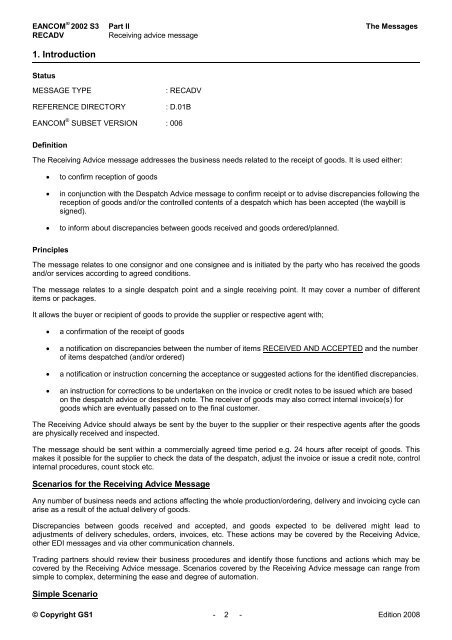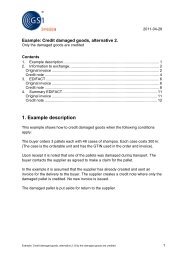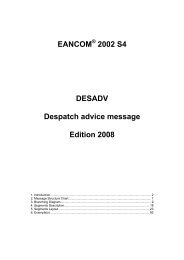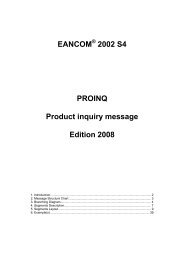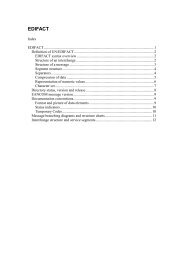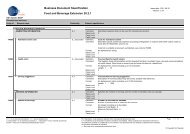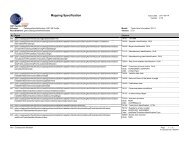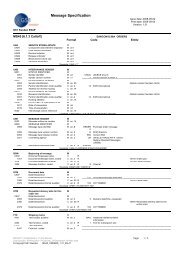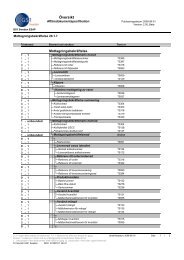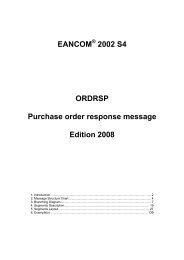EANCOM 2002 S3 RECADV Receiving advice message ... - GS1
EANCOM 2002 S3 RECADV Receiving advice message ... - GS1
EANCOM 2002 S3 RECADV Receiving advice message ... - GS1
- No tags were found...
You also want an ePaper? Increase the reach of your titles
YUMPU automatically turns print PDFs into web optimized ePapers that Google loves.
<strong>EANCOM</strong> ® <strong>2002</strong> <strong>S3</strong> Part II The Messages<strong>RECADV</strong><strong>Receiving</strong> <strong>advice</strong> <strong>message</strong>1. IntroductionStatusMESSAGE TYPEREFERENCE DIRECTORY: <strong>RECADV</strong>: D.01B<strong>EANCOM</strong> ® SUBSET VERSION : 006DefinitionThe <strong>Receiving</strong> Advice <strong>message</strong> addresses the business needs related to the receipt of goods. It is used either:• to confirm reception of goods• in conjunction with the Despatch Advice <strong>message</strong> to confirm receipt or to advise discrepancies following thereception of goods and/or the controlled contents of a despatch which has been accepted (the waybill issigned).• to inform about discrepancies between goods received and goods ordered/planned.PrinciplesThe <strong>message</strong> relates to one consignor and one consignee and is initiated by the party who has received the goodsand/or services according to agreed conditions.The <strong>message</strong> relates to a single despatch point and a single receiving point. It may cover a number of differentitems or packages.It allows the buyer or recipient of goods to provide the supplier or respective agent with;• a confirmation of the receipt of goods• a notification on discrepancies between the number of items RECEIVED AND ACCEPTED and the numberof items despatched (and/or ordered)• a notification or instruction concerning the acceptance or suggested actions for the identified discrepancies.• an instruction for corrections to be undertaken on the invoice or credit notes to be issued which are basedon the despatch <strong>advice</strong> or despatch note. The receiver of goods may also correct internal invoice(s) forgoods which are eventually passed on to the final customer.The <strong>Receiving</strong> Advice should always be sent by the buyer to the supplier or their respective agents after the goodsare physically received and inspected.The <strong>message</strong> should be sent within a commercially agreed time period e.g. 24 hours after receipt of goods. Thismakes it possible for the supplier to check the data of the despatch, adjust the invoice or issue a credit note, controlinternal procedures, count stock etc.Scenarios for the <strong>Receiving</strong> Advice MessageAny number of business needs and actions affecting the whole production/ordering, delivery and invoicing cycle canarise as a result of the actual delivery of goods.Discrepancies between goods received and accepted, and goods expected to be delivered might lead toadjustments of delivery schedules, orders, invoices, etc. These actions may be covered by the <strong>Receiving</strong> Advice,other EDI <strong>message</strong>s and via other communication channels.Trading partners should review their business procedures and identify those functions and actions which may becovered by the <strong>Receiving</strong> Advice <strong>message</strong>. Scenarios covered by the <strong>Receiving</strong> Advice <strong>message</strong> can range fromsimple to complex, determining the ease and degree of automation.Simple Scenario© Copyright <strong>GS1</strong> - 2 - Edition 2008


